|
Scientific Live Show
|
Universe is a computerized theater system for scientific education in Science Museum at Kitanomaru Park in downtown Tokyo. Computer graphics produced by SGI Power Onyx is projected by a 200-inch HDTV projector. Hands-On Universe Telescope at Leishner observatory of University of California at Berkeley can be controlled through Internet from Universe to realize the real-time observations in day time in Japan using the time difference between Japan and California. Every Saturday afternoon, we perform two scientific live shows of about 40 minutes. Over 200 live shows are performed since April 1996. Volunteer university students are deeply involved in the developments and operations of Universe.
Å@Universe is a computerized theater system for scientific education in Science Museum at Kitanomaru Park in downtown Tokyo (Figure 1). It is a hall with about 70 sheets for audience. Computer graphics produced by SGI Power Onyx is projected by a 200-inch HDTV projector. An SGI 4D Indy in the hall controls the whole computer, audio, and lighting system. The SGI Power Onyx are connected to the Internet through a 128 kbit line. Hands-On Universe Telescope at Leishner observatory of University of Califfornia at Berkeley can be controlled through Internet from Universe for the real-time observations. Furthermore, we can surf the web and enjoy various home pages in the world with a 200 inch screen.
Every Saturday afternoon, a host and two assistants perform two scientific live shows of about 40 minutes. The host conducts the show using a lot of pictures and computer graphics movies. The assistants operate the computer system by the request from the host. The first live show are performed on April 21st, 1995. Since then, over 200 live shows are performed. The total number of the audience to join the live shows exceeds 800. Volunteer university students are deeply involved in the developments and operations of Universe. For example, almost all application software used in Live Show are developed by them.
In the present paper, we give brief descriptions of the concepts and contents of the Universe live show
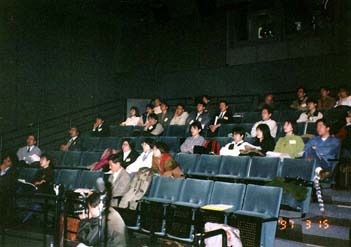
A live show is composed of three or four sessions picked up from the following five programs, which are almost independent of each other. Those are Solar System Simulation Live, HOU Live Observation, Galaxy Collision Simulation Live, Gravitational Lens Simulation Live, and Guest Corner.
In Solar System Simulation live, host uses a computer software, named Solar System Simulator. The software can simulate various astronomical phenomena such as motions of planets (figure 2) and Galileian satellites of Jupiter, meteor swarm, and solar eclipse (figure 3), the night sky view from the earth; orbital parameters of all planets, some comets, and Galileian satellites of Jupiter, and the moon are set as well as positional data of stars on the celestial sphere. A host can explain how our solar system looks like, why Galileian satellites moves around Jupiter, how meteor swarm occurs by a dust swarm emitted by a comet, and why a solar eclipse occurs.

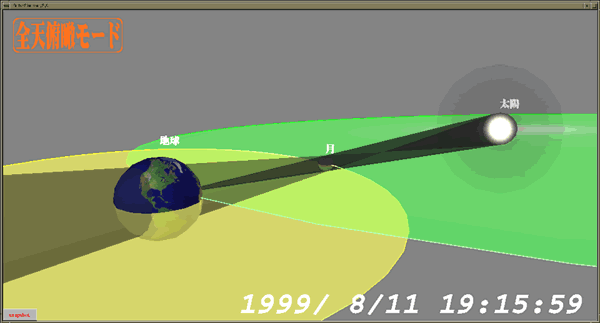
In HOU Live Observation, we use HOU telescope at Leishner Observatory of University of California Berkeley through the Internet. Since the time difference between Japan and California is seven or eight hours (depends on daylight saving time), we can observe astronomical objects from Japan in day time. Audience can choose objects to observe from the list of the recommend objects for that day. A host shows locations of the targets by Solar System Simulator. The assistant sends commands to HOU telescope. The telescope observes that object according as the command and sends the image to Universe. It takes about 3 minutes to transfer an image. When it is cloudy on Leishner observatory, the host uses archived images from the telescope and explains about it.
A host first gives brief descriptions about a galaxy and shows the pictures of various types of galaxies, including interacting galaxies such as Cartwheel galaxies and Antenna galaxies. He explains the peculiar shapes of these galaxies in terms of galaxy-galaxy collision using computer graphics movies based on N-body simulation. After that, the real-time simulation of a galaxy collision is performed using GRAPE (GRAvity PipE)-3AF connected to SGI Power Onyx. GRAPE-3AF is a special purpose computer for gravitational many body systems (Okumura et al. 1993). The host picks up an audience and asks him or her to set the parameters of the collision to perform. The simulation can be seen from arbitrary point of view (figure 4). The highlight scene of the collision is printed by a color printer and given to the person, who adapt the parameters as a souvenir.
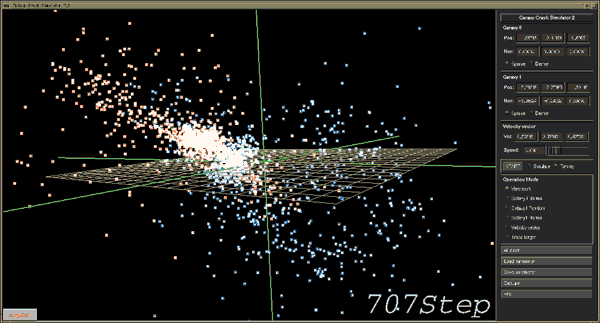
A host first describes about what is gravitational lens using M31 image as a background (figure 5) and the picture of a lensed cluster galaxy taken by Hubble Space Telescope. After the explanation, the host picks up an audience and take a photo image of his or her face. The picture is used as background of gravitational lens, and deformed. The person who was taken image can place the black hole wherever he or her likes. The deformed image is printed and given to him or her as a souvenir.
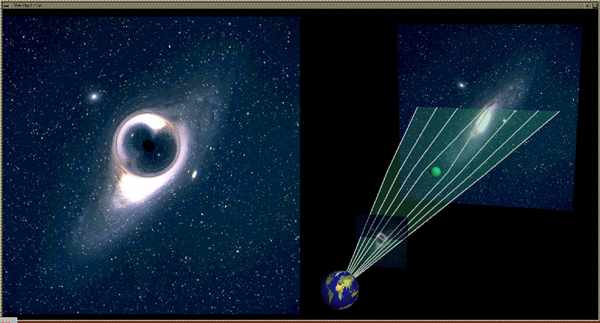
A scientist is invited to the live show. A host and guest have and casual conversations about guest's research subject. The guest describes his or her works with several pictures.
We performed several special events as follows.
Two hosts [one (T.E.) at Universe and the other (T. H.) at event place of Nobeyama Radio Observatory] performs the special live show. NRO and Science Museum were connected with CU SeeMe through the Internet. The radio images were sent from NRO to Universe and optical images were sent from Universe to NRO. The hosts discussed the story of star formation using these images.
In 1997, a volunteer group promoted a campaign, named LIVE!ECLIPSE97, on the total solar eclipse in east Siberia. Many citizens with various backgrounds were joined to the group; the campaign was originated by non-professional solar eclipse watchers. One demonstration of the campaign was performed at Universe on the day of eclipse. Using the facility of Universe, a host showd real-time movies of total eclipse at Siberia and semi-real-time photos of partial eclipse at several locations in Japan, which were collected for LIVE!ECLIPSE97 through the Internet. The host explained the mechanism of a solar eclipse using the ground based images and Solar System Simulator. The current research works on the sun was also presented by a professional researcher.
JAHOU Kick off Meeting (March 15 1997)
JAHOU is a Japanese branch of global Hands on Universe (HOU) Collaborations (Barclay et al. 1992; Pennypacker et al. 1998;figure 6). The kick-off meeting was held on March 15, 1997 in Universe with 50 participants. HOU is the innovative program of scientific education, in which high-school students do researches of the astronomical objects with the image processing software on personal computers and the Internet. We also had several CU-SeeMe sessions with Lawrence Berkeley Laboratory, Adler planetarium in Chicago and Misato Observatory in Wakayama Japan.
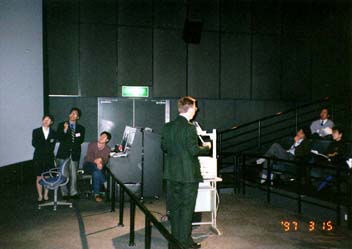
Universe Live Show is continuously changing week by week. Two programs are developing for Universe Live Show. One is International Space Station Live. In this program, a host describes the International Space Station using a software, in which we can virtually fly around it. The other program is Evolution of Star Live, in which audience can learn the life of stars.